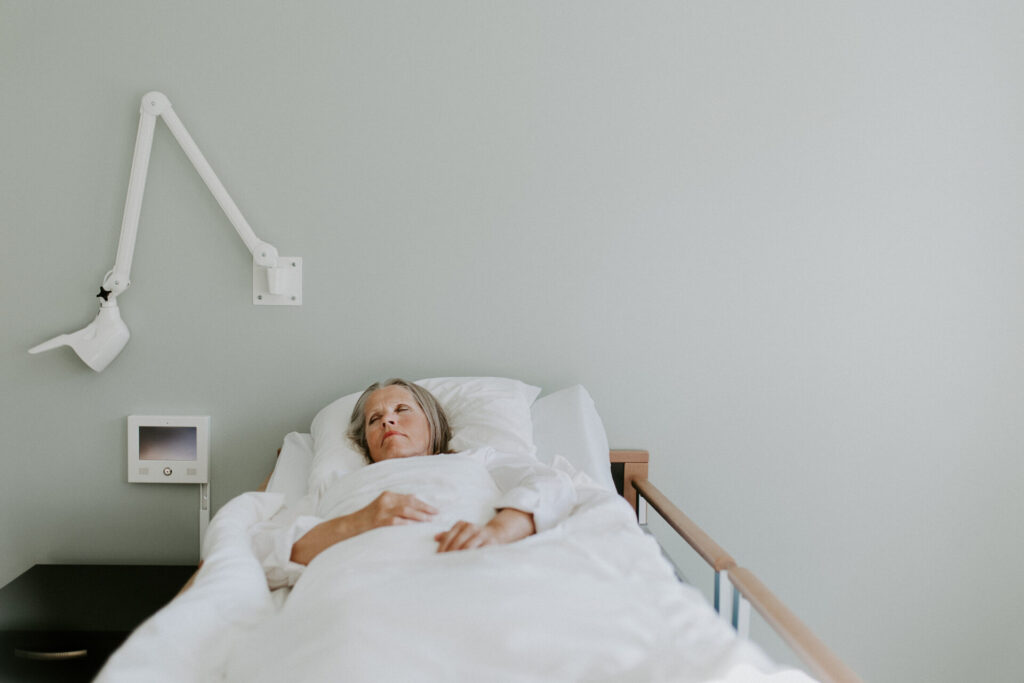What are bedsores, and why is treatment so important?
Bed sores – also called pressure ulcers – occur when the skin and underlying tissues are damaged due to prolonged pressure. They often develop in patients who lie still a lot, and without proper intervention , the wounds can progress rapidly from redness to open wounds and infections.
Treatment and prevention is not just about repositioning the patient – it requires thorough wound treatment, continuous skin care and close follow-up by several professional groups. In this article, we go in-depth on three crucial measures, and look in particular at how Tidewave can support the whole process.
1. Careful wound care and cleaning – essential for healing
Once a bedsore has occurred, professional wound care is key. The wounds can be superficial (category 1–2) or deep and complex (category 3–4), and the treatment must be adapted accordingly.
What does good wound care involve?
-
Daily inspection and cleaning of the wound, preferably with physiological saline or gentle antiseptics.
-
Removal of dead tissue (debridement) to prevent infection and stimulate new tissue growth.
-
The use of modern dressing materials such as foam bandages, hydrofiber or silver bandages, depending on the condition of the wound and the level of secretion.
A critical aspect of wound care is that the pressure on the wound must be reduced. Here , Tidewave has proven to be a very effective solution. By automatically turning the patient evenly throughout the day, the mattress contributes to continuous pressure relief – which improves circulation in the skin and increases the chance that the wound will actually heal.
Wound care without good pressure relief is like brushing your teeth without cutting out sugar – the problem comes back quickly.
2. Skin care and prevention – the most important thing you do before the wound occurs
Bedsores often start with small signs such as redness, irritation or moist skin. Therefore, skin care and preventive measures are absolutely crucial – especially for patients who are at risk, such as the elderly or people with reduced sensation in the skin.
What can you do to protect your skin?
-
Daily skin inspection, especially on pressure-exposed areas such as tailbones, hips, heels and back.
-
Use of moisturiser, preferably with a barrier effect, which strengthens the skin’s natural protection and prevents cracking and dryness.
-
Good hygiene and moisture control, with absorbent underlay and gentle washing – moisture significantly increases the risk of skin damage.
-
Reduce friction and displacement, which often occurs with manual turning or by the patient sliding in bed.
Tidewave comes in handy here. It ensures smooth and gentle movement, which results in far less friction than traditional manual turning. The patient gets better sleep and the skin is allowed to breathe, without constant strain on the same areas.
For many institutions and patients living at home, the transition to Tidewave has not only resulted in fewer wounds – but also less need for emergent measures afterwards.
3. Interdisciplinary follow-up – a holistic approach gives better results
Bedsore treatment is never a one-man job. It requires close collaboration between several professional groups to provide the patient with the best possible treatment and prevention.
Who should be part of the team?
-
Nurse – responsible for wound care, assessment of wound development and adaptation of dressings.
-
Doctor – assesses the degree of severity, prescribes any antibiotics, and follows up on chronic cases.
-
Physiotherapist – assists with mobilization, position changes and assessment of pressure distribution.
-
Nutritionist – although we won’t go into depth here, good nutrition is always part of the healing process.
-
Technological support personnel – especially using special equipment such as Tidewave, to ensure proper installation and use.
By introducing technology that relieves the staff, as Tidewave does, you free up time and resources to focus on professional follow-up, individual assessment and more holistic patient care. Many institutions report fewer bedsores, better documentation, and higher satisfaction among both staff and patients after implementing a mattress with continuous movement.
Summary: Bedsores require more than bandages
Bedsores are a complex challenge, but with the right approach, they can largely be prevented – and cured. The three most crucial measures are:
-
Thorough and customized wound care with modern products and the right pressure relief.
-
Daily skin care and prevention, which prevents the development of wounds before they start.
-
Interdisciplinary collaboration, where technology such as Tidewave frees up time and improves the quality of care.
By thinking holistically and using smart aids, we can give patients a better quality of life and prevent long-term health problems. Tidewave is not just a product – it is a tool for better care.
